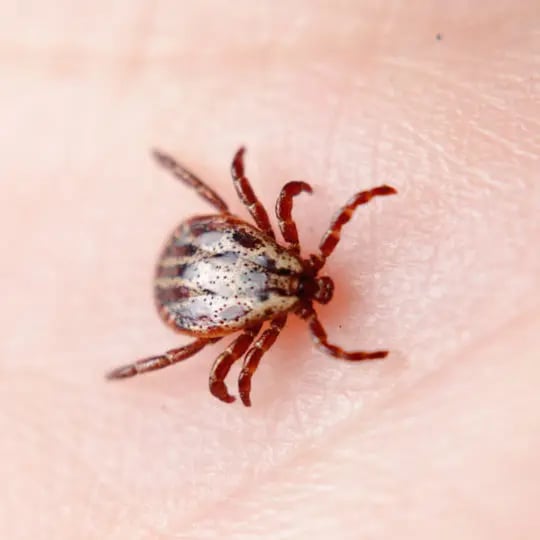
Scientific Name: Ixodida
Lifespan: Varies. Some live 1+ years
Problem: Blood sucking, itching, possible spread of disease
Ticks (Ixodida) are parasitic insects belonging to the arachnid family. Ticks suck the blood of humans and animals alike, without the host body being aware due to the numbing chemicals they inject into our skin. Their hard shells make them difficult to kill by crushing or even stepping on them, despite their minute size, unless they have recently fed and are engorged with blood. Sometimes removing a tick may also be difficult.
Ticks are also potential carriers of a number of serious illnesses, including Lyme disease, Rocky Mountain spotted fever, Colorado tick fever, and tick paralysis, among various others.
The Tick Life Cycle
- Eggs – Female ticks die after laying their eggs, which usually number between 1,000 and 3,000. After 2-7 weeks, the tick eggs hatch into larvae, which are very tiny, 6-legged versions of their adult selves. After feeding on a host larvae fall to the ground and molt, becoming juvenile ticks or “seed ticks.”
- Juveniles – Juvenile ticks are 8 legged, like their adult counterparts, and once again must find a host and feed for between 3 and 10 days before it falls, molts, and enters the next phase of its life.
- Mature Bugs – Mature ticks are circular in shape and brownish-black in color, with 8 shiny black legs and two minute antennae protruding from the tops of their heads. They are smallest and dark in color prior to feeding, becoming larger and more bulbous in shape while drinking blood (at their largest, ticks can be the size of a pinkie fingernail). At this stage, the tick begins to reproduce.
Tick Habitats and Habits
Ticks prefer warm climates and humidity, as they require warmth to develop from eggs into larvae and humidity to molt and evolve further. Locations featuring deer, sand-based soil, rivers and hardwood trees are also attractive to ticks.
Rather than jumping on their prey in order to feed on them, ticks engage in a hunting behavior known as “questing.” A questing tick holds onto grass blades with its back legs and raises its forelegs into the air, waiting to grab onto of passing animals and humans.
How to Recognize and Get Rid of a Tick Infestation
Ticks prefer the outdoors to indoors and most tick types will not live or multiply inside the house. However, if your lawn is infested with ticks, either you or your pets are likely to notice due to finding multiple ticks attached to your body, usually in warm, humid locations such as ears, armpits and the backs of knees.
To get rid of ticks indoors, wash all dirty clothes and sheets and vacuum to remove tick eggs and the ticks themselves. Outdoors, you can mow grass short to keep it from creating the shady, moist environment ticks prefer, and keep tick-carrying animals such as deer off of your lawn by building fences and removing birdfeeders. Because of the risk of disease and how difficult it may be to spot ticks and tick bites, professional treatment is often necessary.
Need Help with Learn About Ticks and Prevention | Green Pest Solutions?
Call today at and let's talk about how we can help you with Learn About Ticks and Prevention | Green Pest Solutions and other Pest Library.